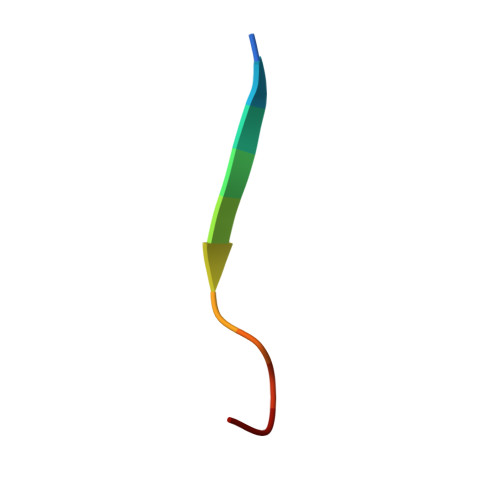Atomic structure of a toxic, oligomeric segment of SOD1 linked to amyotrophic lateral sclerosis (ALS).
Sangwan, S., Zhao, A., Adams, K.L., Jayson, C.K., Sawaya, M.R., Guenther, E.L., Pan, A.C., Ngo, J., Moore, D.M., Soriaga, A.B., Do, T.D., Goldschmidt, L., Nelson, R., Bowers, M.T., Koehler, C.M., Shaw, D.E., Novitch, B.G., Eisenberg, D.S.(2017) Proc Natl Acad Sci U S A 114: 8770-8775
- PubMed: 28760994
- DOI: https://doi.org/10.1073/pnas.1705091114
- Primary Citation of Related Structures:
5DLI, 5IIW - PubMed Abstract:
Fibrils and oligomers are the aggregated protein agents of neuronal dysfunction in ALS diseases. Whereas we now know much about fibril architecture, atomic structures of disease-related oligomers have eluded determination. Here, we determine the corkscrew-like structure of a cytotoxic segment of superoxide dismutase 1 (SOD1) in its oligomeric state. Mutations that prevent formation of this structure eliminate cytotoxicity of the segment in isolation as well as cytotoxicity of the ALS-linked mutants of SOD1 in primary motor neurons and in a Danio rerio (zebrafish) model of ALS. Cytotoxicity assays suggest that toxicity is a property of soluble oligomers, and not large insoluble aggregates. Our work adds to evidence that the toxic oligomeric entities in protein aggregation diseases contain antiparallel, out-of-register β-sheet structures and identifies a target for structure-based therapeutics in ALS.
- Howard Hughes Medical Institute, UCLA-DOE and Molecular Biology Institutes, Department of Biological Chemistry, University of California, Los Angeles, CA 90095.
Organizational Affiliation:
















